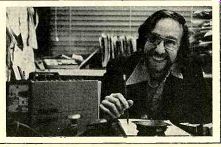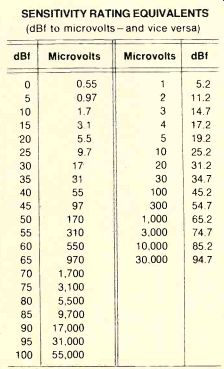
By Larry Klein, Technical Editor
Femto ... What?
Q. Now that we have been stuck with (or Q. blessed with-depending upon the view point) femtowatt FM sensitivity ratings, could you provide a conversion chart of microvolt dBf equivalents? Two additional questions:
Why the change from microvolts? And what does "femto" mean?
-ALFRED NEWBURG; Bronx, N.Y.
A. You'll find a dBf-to-microvolts—and vice versa-conversion chart below; it is reprinted from Julian Hirsch's discussion of the new IHF tuner standard in his "Technical Talk" column last December. As to the why of the conversion: there has always been some confusion in the use of microvolt FM-tuner sensitivity ratings because of the need to specify the load seen by the generator as well. This included the network that coupled it to the tuner's antenna terminals plus the impedance of the antenna-input circuit. (Tuners sold in England always seemed to have twice the sensitivity of their U.S. counter parts simply because they were rated using a 75-ohm FM input impedance rather than the U.S. standard of 300 ohms. The situation was somewhat analogous to specifying the voltage output at an amplifier's speaker terminals rather than the power in watts produced across the load resistor.) The new standard refers all input-signal levels to a 0-dB reference of 10-15 watts, or 1 femtowatt. Before I researched the question, I thought "femto" might be a coined term, possibly derived from the femlin--the female companion of W.W.II's gremlin. It is not. Femto is based on a Scandinavian root (rather than the more usual Greek and Latin ones that give us micro-, nano-, mega-, pico-, etc.) meaning "fifteen."
Components--Far and Near
Q. I'm told that when installing separate components you should leave a certain physical distance between units. What can happen to the sound reproduction if the spacing is wrong?
MICHAEL MULLER, APO, New York
A. Lots of different things. The problems that can occur-but probably won't--are these: (1) hum, (2) loss of highs, (3) over heating, and (4) acoustic feedback. Let's look at hum first. Power transformers and motors radiate hum fields; phono cartridges, tape heads, and high-gain (preamplifier) stages pick up hum fields. Therefore, you may run into hum problems if your record player, tape deck, or preamp is installed very close to your power amplifier-including above or below it.
Wooden shelves are not hum shields. If you suspect that the physical setup of your components is the source of hum, the way to find out for sure is to rearrange the units temporarily to see if things quiet down.
Loss of highs is an easy one to solve-don't run long shielded cables ("long" is defined as being much over 6 feet) between components unless the manufacturer's instruction manual says you can. This is particularly true of pho no leads-and the manufacturer to check with is the one that produced the phono cartridge, not the turntable.

------- SENSITIVITY RATING EQUIVALENTS (dBf to microvolts-and vice versa) dBf Microvolts Microvolts dBf
To check the effect of cable length on your sound, temporarily place the units close enough for use with 3- or 4-foot cables and listen to interstation FM noise or recorded pink noise. Then, without repositioning the components, substitute the longer cable lengths.
Do the high ssss's disappear from the sound? If you can get them back to their original strength by resetting the speaker's tweeter-level control or the amplifier's treble control then you have one solution at hand. It's also possible to use low-capacitance shielded coaxial antenna cable (with phono plugs attached) to eliminate a lot of capacitance.
(Don't do as I once did and use square waves as a signal source to judge high-frequency rolloff. My oscilloscope did, in truth, show that there wasn't any high-frequency loss in the signal reaching the speakers. However, since I blew out my tweeters while making the test, there was a subsequent severe high-frequency acoustic loss.) These days overheating is likely to come about only as a result of inadequate ventilation-usually of the power amplifier (or integrated amplifier). Keep the amplifier's heat sinks clear of obstructions to allow whatever heat is produced to get out and away. As a rule of thumb (your forefinger will serve, however), simply touch the heat sink. If it's too hot to touch, it's too hot, period! It could be that the amp's internal bias setting has drifted off, or that you have been driving it too hard, or that there simply isn't enough opportunity for air flow-or all of the above.
You can check the bias setting by leaving the amplifier on but with no signal going through it. If it still overheats, drop a note to the factory asking how hot a product they've got.
Describe the ventilation available to your amplifier to provide them with some frame of thermal reference.
Acoustic feedback has been discussed at length in these pages and occurs because the sound vibrations from the speaker(s) is some how shaking the record player. This can hap pen if, for example, the player and speaker are installed on the same shelf or furniture surface even though separated by 6 or 7 feet.
The solution is better isolation achieved by physical separation-or the use of an isolating sub-base under the player, or foam rubber un der the speakers, or both.
In general, I suspect that common sense will prevent most of the above problems from ever happening. But if you do run into trouble, consult the instruction manual. There may be some words of wisdom relating to your particular problem concealed within the of times plodding prose.
Playback-only Decks
Q. Could you please send me information on any company that makes playback--only open--reel tape decks?
SEBASTIAN CARBORIOUS; Wyandanch, N.Y.
A. As far as I know there aren't any. It seems that in this day of solid-state circuits, the additional cost of the electronics and other parts necessary to convert a play back-only deck to a record/playback deck is a small enough percentage of the overall cost of the product that, in consideration of the sales that may be lost by omission of the recording function, it makes no sense to leave it out.
Because the number of questions we receive each month is greater than we can reply to individually, only those letters selected for use in this column can be answered. Sorry!
------------
Also see:
NEW PRODUCTS--A roundup of the latest in high-fidelity equipment
UNDERSTANDING RECORD PLAYERS: What you should know before you go out shopping, JULIAN D. HIRSCH
In the Groove: Close-Up View of Record Wear (Audio, Sept. 1980)
EQUIPMENT TEST REPORTS--Hirsch-Houck Laboratory test results on: the Akai GXC-325D stereo cassette deck, Stax SR-5 stereo headphones, Design Acoustics D-2 speaker system, and Lenco L-85 turntable, JULIAN D. HIRSCH